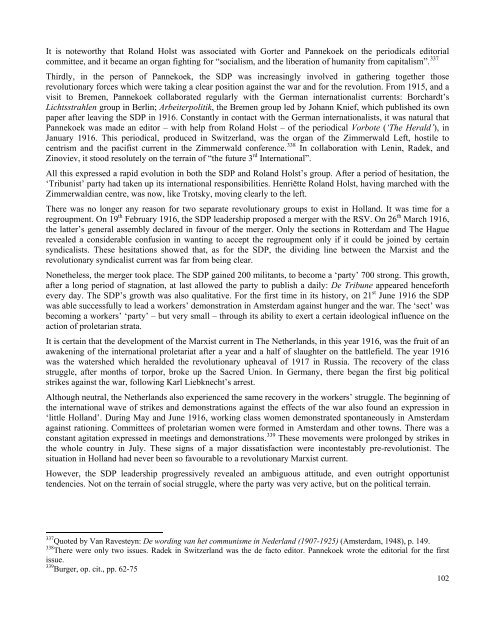The German-Dutch Communist Left - Libcom
The German-Dutch Communist Left - Libcom
The German-Dutch Communist Left - Libcom
Create successful ePaper yourself
Turn your PDF publications into a flip-book with our unique Google optimized e-Paper software.
It is noteworthy that Roland Holst was associated with Gorter and Pannekoek on the periodicals editorial<br />
committee, and it became an organ fighting for “socialism, and the liberation of humanity from capitalism”. 337<br />
Thirdly, in the person of Pannekoek, the SDP was increasingly involved in gathering together those<br />
revolutionary forces which were taking a clear position against the war and for the revolution. From 1915, and a<br />
visit to Bremen, Pannekoek collaborated regularly with the <strong>German</strong> internationalist currents: Borchardt’s<br />
Lichtsstrahlen group in Berlin; Arbeiterpolitik, the Bremen group led by Johann Knief, which published its own<br />
paper after leaving the SDP in 1916. Constantly in contact with the <strong>German</strong> internationalists, it was natural that<br />
Pannekoek was made an editor – with help from Roland Holst – of the periodical Vorbote (‘<strong>The</strong> Herald’), in<br />
January 1916. This periodical, produced in Switzerland, was the organ of the Zimmerwald <strong>Left</strong>, hostile to<br />
centrism and the pacifist current in the Zimmerwald conference. 338 In collaboration with Lenin, Radek, and<br />
Zinoviev, it stood resolutely on the terrain of “the future 3 rd International”.<br />
All this expressed a rapid evolution in both the SDP and Roland Holst’s group. After a period of hesitation, the<br />
‘Tribunist’ party had taken up its international responsibilities. Henriëtte Roland Holst, having marched with the<br />
Zimmerwaldian centre, was now, like Trotsky, moving clearly to the left.<br />
<strong>The</strong>re was no longer any reason for two separate revolutionary groups to exist in Holland. It was time for a<br />
regroupment. On 19 th February 1916, the SDP leadership proposed a merger with the RSV. On 26 th March 1916,<br />
the latter’s general assembly declared in favour of the merger. Only the sections in Rotterdam and <strong>The</strong> Hague<br />
revealed a considerable confusion in wanting to accept the regroupment only if it could be joined by certain<br />
syndicalists. <strong>The</strong>se hesitations showed that, as for the SDP, the dividing line between the Marxist and the<br />
revolutionary syndicalist current was far from being clear.<br />
Nonetheless, the merger took place. <strong>The</strong> SDP gained 200 militants, to become a ‘party’ 700 strong. This growth,<br />
after a long period of stagnation, at last allowed the party to publish a daily: De Tribune appeared henceforth<br />
every day. <strong>The</strong> SDP’s growth was also qualitative. For the first time in its history, on 21 st June 1916 the SDP<br />
was able successfully to lead a workers’ demonstration in Amsterdam against hunger and the war. <strong>The</strong> ‘sect’ was<br />
becoming a workers’ ‘party’ – but very small – through its ability to exert a certain ideological influence on the<br />
action of proletarian strata.<br />
It is certain that the development of the Marxist current in <strong>The</strong> Netherlands, in this year 1916, was the fruit of an<br />
awakening of the international proletariat after a year and a half of slaughter on the battlefield. <strong>The</strong> year 1916<br />
was the watershed which heralded the revolutionary upheaval of 1917 in Russia. <strong>The</strong> recovery of the class<br />
struggle, after months of torpor, broke up the Sacred Union. In <strong>German</strong>y, there began the first big political<br />
strikes against the war, following Karl Liebknecht’s arrest.<br />
Although neutral, the Netherlands also experienced the same recovery in the workers’ struggle. <strong>The</strong> beginning of<br />
the international wave of strikes and demonstrations against the effects of the war also found an expression in<br />
‘little Holland’. During May and June 1916, working class women demonstrated spontaneously in Amsterdam<br />
against rationing. Committees of proletarian women were formed in Amsterdam and other towns. <strong>The</strong>re was a<br />
constant agitation expressed in meetings and demonstrations. 339 <strong>The</strong>se movements were prolonged by strikes in<br />
the whole country in July. <strong>The</strong>se signs of a major dissatisfaction were incontestably pre-revolutionist. <strong>The</strong><br />
situation in Holland had never been so favourable to a revolutionary Marxist current.<br />
However, the SDP leadership progressively revealed an ambiguous attitude, and even outright opportunist<br />
tendencies. Not on the terrain of social struggle, where the party was very active, but on the political terrain.<br />
337 Quoted by Van Ravesteyn: De wording van het communisme in Nederland (1907-1925) (Amsterdam, 1948), p. 149.<br />
338 <strong>The</strong>re were only two issues. Radek in Switzerland was the de facto editor. Pannekoek wrote the editorial for the first<br />
issue.<br />
339 Burger, op. cit., pp. 62-75<br />
102
















